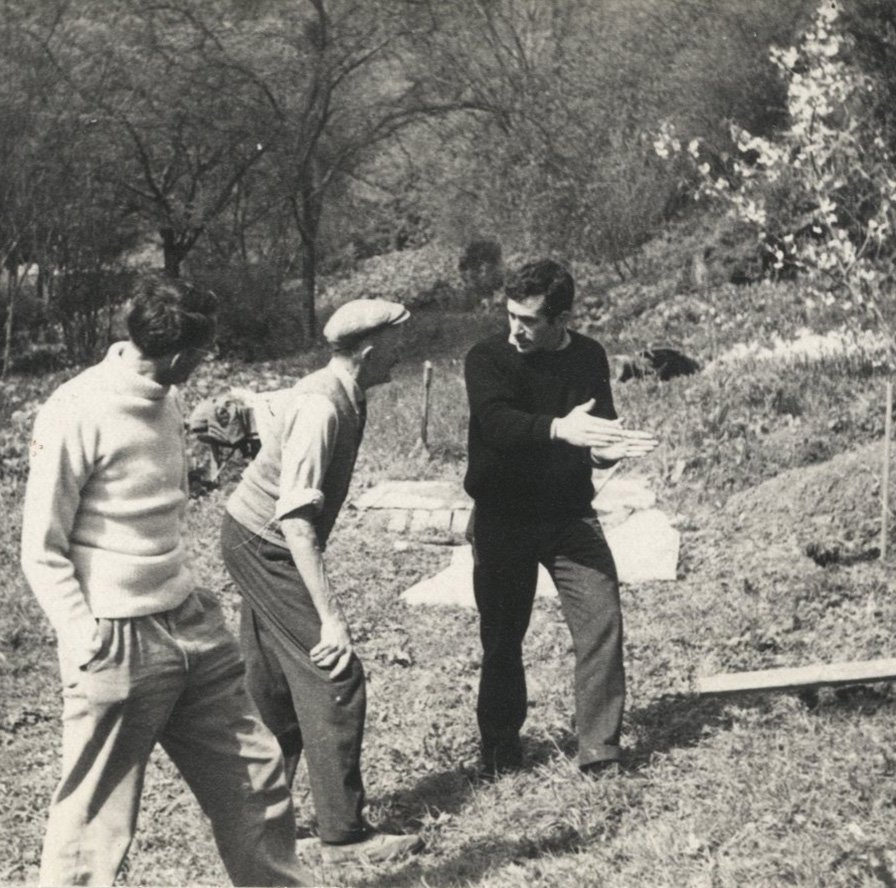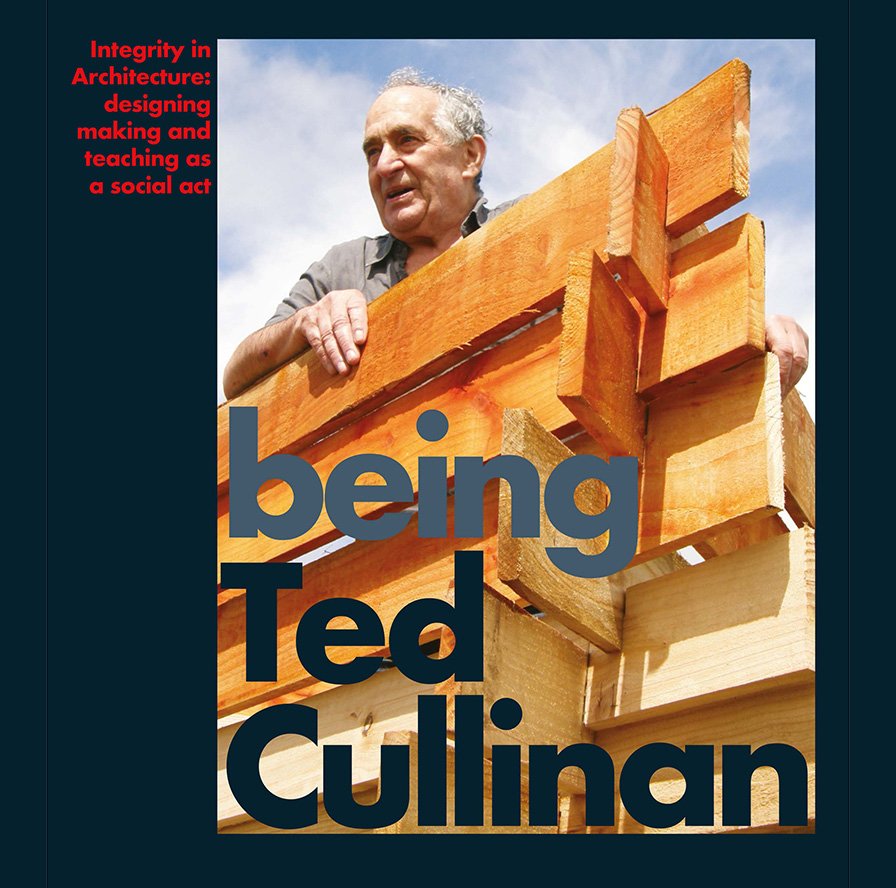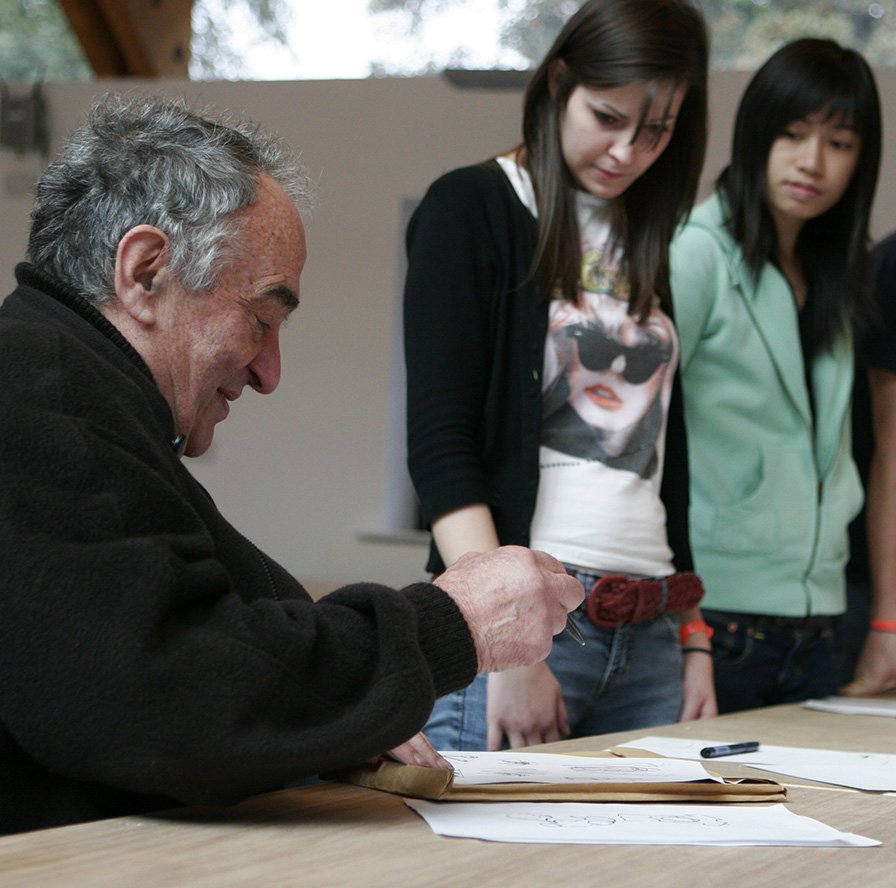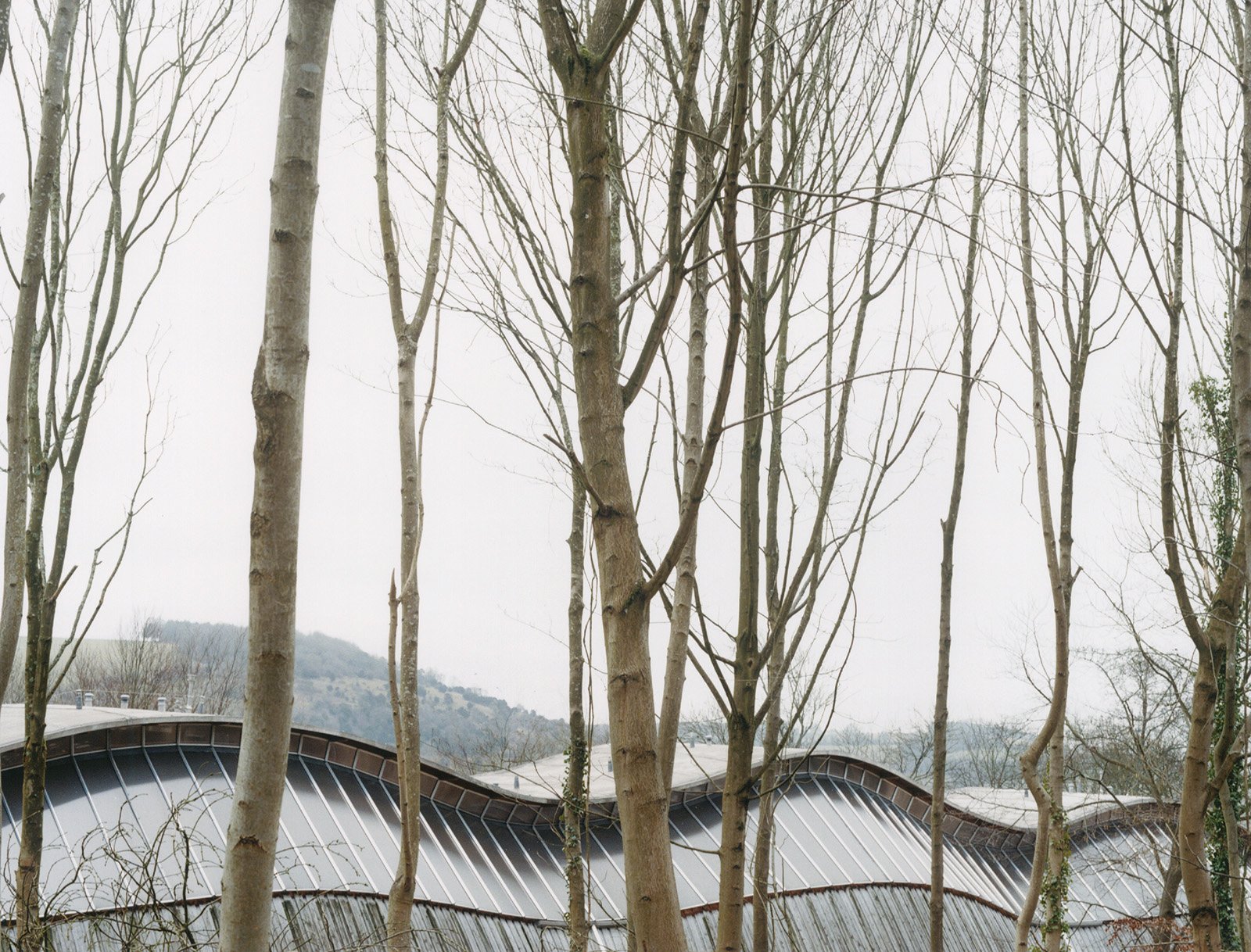Being Ted Cullinan - designing, making and teaching as a social act
Edward Cullinan (1931-2019) was one of the most respected and charismatic architects of his era. A new book, Being Ted Cullinan, examines his life, work and legacy through perspectives by more than 30 friends, colleagues and historians.
In this extract from his introduction to the book, editor ALAN BERMAN looks at how Ted’s values, teachings and unique ways of thinking were frequently ahead of their time, leaving a legacy of pioneering buildings and inspiring new generations of architects…
Ted Cullinan was an iconoclast: so much of what he practiced and taught was contrary to mainstream British architecture that it took many failed nominations before he was awarded the Royal Gold Medal in 2008. While the ‘star’ architects of his generation took to the world stage in designer suits, showcasing their extraordinary skills, Ted would be down on his Derbyshire farm in black tee-shirt and jeans, ankle-deep in mud. With colleagues and friends he was cutting, hammering, experimenting and exploring the qualities of materials, always learning about making buildings. Or he might be marching to Trafalgar Square, demonstrating against injustice or for some humanitarian cause.
Ted Cullinan’s way of being an architect was very particular, very grounded and deeply human.
In his practice and teaching Cullinan always followed his conviction that architects need a deep understanding of materials and construction to inform their creative imaginations so that, above all, they could serve people and communities. He aimed to work for better futures for everyone by making architecture ‘with people and for people’ – a credo which underpinned almost everything he did in his life and work.
Cullinan’s values were rooted in his upbringing by Christian socialist parents and his schooling at Ampleforth, where he and his two younger brothers were taught the caring values and discipline of the Benedictine order. His architectural office was established from the outset as a profit-sharing cooperative which valued everyone for who they were and for their ideas. The extent of his commitment to cooperative working was set out in an unusual practice manifesto which stated: ‘Fees are shared in agreed proportions as and when they are received; any surplus is shared out or used otherwise by agreement. Making the practice have no book value ensures that it is no one’s possession nor anyone its servant’. That an ambitious young architect should conceive a practice with this extent of sharing, and with the intention that his working life would result in zero asset value, is in marked contrast to those for whom architectural practice is only a business venture. Cullinan understood that, as with makers, craftspeople and artists, the real assets of the architect are creative imagination, curiosity and skills, and an ability to look at things differently.
Edward Cullinan Architects in 1977
Notwithstanding Ted’s commitment to collective endeavour, when working in the studio he would often deploy his considerable persuasive skills to steer designs in the direction he wanted. His talent was not only to originate but to absorb, adapt and remake ideas and mould them into his own particular architecture.
Cullinan’s architecture was based on clear, pragmatic principles that were developed early and held throughout his career. A key tenet was that a building’s design should meet the needs and aspirations not only of its commissioning client but of its present and future users. Cullinan was not interested in the kind of architectural form-making which preoccupied many of his contemporaries, nor was he inclined to articulate any particular theory, but he did have a deep understanding of architectural history. He was in accord with philosopher John Dewey’s view that buildings ‘celebrate with particular intensity the moments in which the past reinforces the present… which also suggests the future’. Cullinan’s acute analysis of historic buildings informed many of his own designs in which he reinterpreted established forms and technologies in a contemporary manner. He would also cite historic examples to help explain his own ideas to colleagues and clients, not to legitimise them but rather to communicate the way a design might serve its occupants’ needs.
The contemporary urge to fashion novel and abstract forms and reject traditional types represented for Cullinan a corruption of the truly modern ideals that, for him, were exemplified by the hands-on workshop production of the Bauhaus, with its ‘truth to materials’ ethos. He learned much from a detailed study of the design inventions of the Modern Movement, and he particularly admired the potency of form, space and light, the importance of the plan and the organisational significance of the ‘promenade architecturale’ in the work of Le Corbusier. He also admired Frank Lloyd Wright and Louis Kahn for their command of materials, and how they were unashamed to embrace vernacular traditions. He was among the first post-war British architects to appreciate and take lessons from the straightforward construction and appropriate use of local materials in vernacular architecture – an interest which at the time was considered esoteric and somewhat disparagingly labelled as ‘romantic’.
An imperative of that tradition – that buildings are built simply and of local materials – requires an understanding of the ways in which people experience and react to their environment. Ever pragmatic, Cullinan was mindful, for example, of the fact that most people don’t perceive buildings in the way architects do, but rather in terms of what they touch and see from eye level. At a time when deep-plan, artificially-lit spaces were being espoused as efficient and progressive, Cullinan recognised that good daylighting was crucial to peoples’ well-being and their enjoyment of a building; his sketches reveal a constant exploration of ways to admit light and facilitate views out by means of the section. The split-roof became a key organisational component in many of Cullinan’s designs, and often it would be allied to a clear plan which allowed intuitive navigation and reduced the likelihood of people feeling disorientated or inhibited. Circulation spaces were conceived not just as ways of getting from A to B but as opportunities to create useful and enjoyable places to sit, meet, take in a carefully framed view – and they were always full of light.
He regarded materials, texture, colour and detail not so much from a formal point of view, but rather how they would be ‘read’. The reading of a building, the wish to demystify architecture and make it comprehensible, was important – an artless straightforwardness that imbued Cullinan’s whole approach to making buildings. Details were as simple as could be, and flush joints, hidden fixings and sophisticated gaskets were avoided wherever possible. Materials would be lapped over each other with fixings such as bolts or pegs left visible. Joints would be easy to make and celebrated as an essential part of the architecture.
The appreciation and enjoyment of Cullinan’s buildings is heightened by the way in which material quality is exploited – the contrast between the brittle smoothness of glass and the solid roughness of timber, between the warmth of oak boards and the cold feel of stone, between the stick-like quality of a frame and the planar nature of panels or masonry.
Cullinan’s hands-on understanding of materials, combined with an inherent grasp of structural principles, enabled him to develop construction techniques that were simple, economic and buildable. But this didn’t preclude interesting and unusual structures, even when using off-the-peg or as-found materials, as is particularly evident in the Olivetti buildings, St Mary’s Church at Barnes, Westminster Lodge at Hooke Park, and the Weald & Downland Museum Gridshell.
Stirling Prize nominated Downland Gridshell at the Weald and Downland Living Museum, completed 2002
This celebration of the expedient, the ordinary and the readily available reflects Cullinan’s determination to make art from the artless. Buildings involve all the senses, yet with virtually everything now designed on screen, the all-pervading power of the visual sense ironically produces a certain blindness which can occlude the other senses and deny the essential physicality of buildings. Hence the importance Cullinan attached to texture, colour, sound and comfort, and it is these physical qualities that give the practice’s buildings their human character – as Aldo van Eyck put it, architecture can ‘assist man’s homecoming’.
From the early days Ted delighted in the outdoors, and his family and studio team alike shared in many of his hair-raising escapades and construction challenges. Sharing manual work, cooking around camp fires, sledding in the snow and outings to look at buildings in the vicinity all helped to forge the collaborative culture which created such an unusual and warm office environment back in the London studio.
Cullinan’s, generous nature and evident moral convictions naturally attracted many young architects, full of 1960s radical enthusiasms, for here was an architect whose manifesto proclaimed architecture to be a social act and who was vocal about the injustices of America’s war in Vietnam and South Africa’s apartheid system. It is not surprising that the establishment did not feel he was one of them, or that the number of commissions from commercial developers was few. Rather, and initially in an era of increasing state patronage, the majority were buildings for public use with social purpose: visitor centres, libraries, education, health centres and social housing.
Cullinan’s enjoyment of the Derbyshire Dales reflects an appreciation of landscape that is manifest in much of his work, and his stories about how designs were developed would invariably start with a description of the physical features of the site. His reading of the topography was often crucial in establishing the initial strategic layouts. At Fountains Abbey, where as Simon Henley suggests Cullinan ‘made a friend of the site’, his careful analysis of the landscape and its development led to the visitor centre being located on a site quite different to that first envisioned by the client.
Drawing by Ted Cullinan illustrating a surprise view of Fountains Abbey on approach to the new visitor centre, completed in 1992
Explaining ideas is essential for architects, and Cullinan’s communication skills were legendary. The carefully calibrated unfolding of ideas and clear justifications of every aspect of a design, delivered slowly with long pauses, seemingly off-hand but masterfully timed, displayed the skill of an actor and captivated his audience. Storytelling was an essential part of Cullinan’s art and his stories would be illustrated by rapidly drawn yet highly accomplished sketches. These allowed him to express ideas, making them easily grasped not only by colleagues during the design process but also by clients and public audiences. Stories were not only for communication, however, and they were often an integral part of a design’s conception. Cullinan made sketches showing what it might be like as people approached a building, walked through and looked out, and how they might enjoy the spaces: people swinging from balconies, walking their dogs, reading in bed or lifting weights – a warm-hearted nod to Le Corbusier.
Cullinan’s convictions and creativity, his way of practicing, his drawing and making skills and inspiring teaching, and his ability to empathise with anybody, constitute an unusually rare and holistic way of being an architect. His perceptiveness and ability to learn lessons from seeing beyond what most people see is encapsulated in his analysis of the simplest example of vernacular construction – the dry-stone wall. Made without artfulness, dry stone walls require an understanding of stone, manual skill and collaborative work. They are functional and sustainable: stones are cleared from land to make it productive and then reused to build walls to enclose the land; and the walls are repairable and the stone is reusable.
Ted Cullinan’s building of dry-stone walls and his planting of thousands of trees represented acts of hope for the future. So too was his devotion of much time, energy and patience in teaching young architects to use their creativity to build a better world. He was unstinting in his encouragement and support of those in the office, and he remained loyal to those who left to set up their own practices.
This is why Cullinan’s beliefs, his thinking practice and teaching continue to command so much respect. His values remain more relevant than ever in today’s world and should not be forgotten. Hope and a belief in the powers of curiosity, the imagination, creative invention and shared endeavour were in his blood, and kept him optimistic, active and engaged until the last days of his long, productive life.
Ted left us all a typically optimistic valedictory hand-written message, printed on the order of his funeral service: ‘Cheerio my friends… and remember to keep on imagining.’
‘Being Ted Cullinan - Integrity in Architecture: designing, making and teaching as a social act’ (edited by Alan Berman and Ian Latham, published by Rightangle) is available to buy here.
This is an abridged version of the full introduction by Alan Berman.
Alan Berman studied at Cambridge and UCL, worked with Maguire & Murray, and in 1981 set up in practice with Pedro Guedes. In 1996 this became Berman Guedes Stretton, whose work included award-winning educational projects. Author of several books on design and sustainability, Alan edited Jim Stirling and the Red Trilogy and Stirling and Wilford American Buildings, and set up the AJ/BGS Writing Prize. He is an associate fellow of Green Templeton College and honorary fellow of Wolfson College in Oxford, where he is currently an adviser to five colleges and schools.
Post publication of this article, ‘Being Ted Cullinan’ was awarded a 2023 Architectural Book of the Year Award. Congratulations Alan and Ian!







